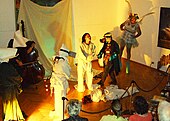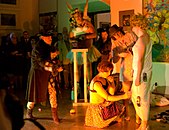Requiem for the cell phones

|
| Requiem for the cell phones |
|---|
| Lubo Kristek , 2007-2010 |
|
interactive assemblage, 300 cm × 210 cm × 80 cm |
Requiem for the cell phone is an interactive assemblage by the sculptor, painter and action artist Lubo Kristek and his series of happenings .
background
Kristek started the happening series in 2007 as a protest against dependence on modern technology. He urged viewers to get rid of their cell phones and created an assemblage of them.
During the first action in the daily Rovnost in Znojmo, the audience sewed the phones directly onto the artist's coat. This coat then became the basis of a new interactive assemblage. With each happening, the assemblage changed its appearance.
The second part took place in 2007 on the sidewalk of Mariahilfer Strasse in Vienna . Kristek dipped a ballerina's pointe shoes in paint and then let them dance on a canvas. The pointe shoes also became part of the assemblage. Then he asked students and passers-by to take part in creating the new assemblage and sewing on the cell phones.
The assemblage moved on to the exhibition at the baroque castle Riegersburg, today Ruegers Castle (2007). The artist also carried his message to other countries, where viewers continued to change the interactive assemblage. The series of happenings continued in 2008 in the New City Museum in Landsberg am Lech and it was part of the retrospective exhibition of Lubo Kristek's works called The Third Eye of Remote Understanding .
“In the happening there was a new appearance of seduction (embodied by the prima ballerina of the National Theater in Brno Jana Přibylová), which presents the audience with electronic achievements from a pink sack and immediately turns into a Satan. In one of the last scenes, this figure plays with the representation of human fate - a black doll that she throws on the floor as soon as she gets enough of her toy. At the end of the happening, Kristek carried the pink sack with the electronic garbage onto the altar of the Landsberg Holy Cross Church . He thereby emphasized the sharp contrast between the legacy of our ancestors and what remains after the present era. "
The following happening took place in 2010 in the Polish city of Sucha Beskidzka . According to Kristek, society's relationship with cell phones shows signs of cult or even pathological addiction . So he put this "modern god" on an altar (with the inscription Sleep Sweet) and had a huge three-breasted angel pierced through him. The visitors of the happening were active participants in the symbolic act of sacrifice of the mobile phones.
“The artist liquidates the mobile phones in the happenings, he disposes of them as rubbish, but at the same time he applies the ritual principle of sacrifice. The annihilated telephone (an analogy to God torn apart) then 'accepts' the happening participants, or they even 'consume' it through its repeated incorporation into the creative process (an analogy to the resurrection). The characters as well as the audience sew the cell phones onto the traveling assemblage and thus become co-authors of the work of art, which changes its appearance from event to event. With his message Requiem, Kristek realizes for the mobile phones what he anticipated on the screen The Mossy Telephone Conversation. He experiments with the involvement of the audience in actions on the border of ritual, performing and visual arts using unintended impulses in a joint creative process and with emphasis on experiencing the current moment. He strives to revive the lost communication and to transform relationships in an alienated 'digital society'. "
literature
- Hartfrid Neunzert : Lubo Kristek: The third eye of remote communication . New City Museum, Landsberg am Lech 2008, OCLC 888617842 .
- Barbora Putová: Kristek's Glyptothek in the Thayatal . VÚKU Brno 2013, ISBN 978-80-905548-2-5 (digital edition), ISBN 978-80-905548-1-8 (print edition).
Web links
- Happening on Mariahilfer Straße, Vienna, 2007 (compilation)
- Happening in the New City Museum, Landsberg am Lech, 2008 (compilation)
- Happening at Muzeum Miejskie, Sucha Beskidzka 2010 (compilation)




